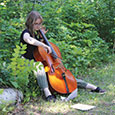Felix Mendelssohn (1809-1847) was a German early Romantic composer, pianist, organist, and conductor. He is credited for reviving interest in the music of J.S. Bach as well as founding the Leipzig Conservatory. As conductor of the Leipzig Gewandhaus Orchestra he was a champion of German composers. Besides composing he was a talented pencil and watercolor artist. He died at the age of 38 after a series of strokes.
Mendelssohn wrote the incidental music to the Midsummer Night’s Dream, Op. 61 in 1842. It was commissioned by King Frederick William IV of Prussia and premiered in Potsdam in 1843. The Scherzo movement was performed between the first and second acts of the play. The work is scored for pairs of flutes, oboes, clarinets, bassoons, horns, trumpets, three trombones, ophicleide (forerunner of the tuba), triangle, cymbals, and strings.
In symphonic and chamber music writing Mendelssohn explores a distinctive writing style in his scherzo movements. The tempos are brisk with staccato articulation marks giving the music an elfin-like quality. Besides the scherzo movements in the symphonies, flutists should explore the Trio in D Minor, Op. 49 for violin, violoncello, and piano (1849). At the request of the English publisher Ewer, Mendelssohn made an arrangement of the violin part for flute in 1850. The 28-minute work is an excellent addition to the Romantic flute chamber music repertoire and features an iconic Mendelssohn scherzo.
The Midsummer Night’s Dream Scherzo is one of the first orchestral excerpts most flutists study. It has one character throughout and the challenges lie in the technical realm. As Nadia Boulanger said, “Music is technique. It is the only aspect of music we can control.” Flute technique should be learned by practicing theoretical fundamentals and etudes first, and not by playing excerpts. Only when students are fluent in the G Minor scale, understand 3/8 meter (compound meter), can double tongue six sixteenth-notes at a metronome marking of 88, have the needed breath control, and have control of playing in the low octave, are they ready to study the Mendelssohn. Assigning this excerpt before students are ready increases the likelihood that they will develop bad habits that will take a lifetime to clean up.
.jpg)
Prep Work
A metronome is essential for practicing this excerpt. While most audition lists suggest a tempo of 88, the more likely tempo in performance will be 80 or 84. Unfortunately in most performances the tempo slows down as the movement progresses. Since the flute solo appears at the end of the movement, the flutist has to play where the tempo has grooved. While a slower tempo may be better for tonguing skills, it can wreak havoc with breathing plans.
Begin students’ work with the G minor scale. To have success in the tonguing aspect of this excerpt, the flute should be balanced firmly in the chin. So many flutists try to play this excerpt with the flute loose in the chin and wonder why the notes do not sound clearly. As they are tonguing, the flute is bouncing around. It is very difficult to direct the air to one minute point on the blow edge if the flute is not still. Having a still flute contributes to the clarity of the tone when tonguing quickly.
Michel Debost suggested placing the right hand on the barrel of the flute and pulling the instrument into the chin. While playing, the left index finger maintains this stability. Help students develop the habit of placing the right hand on the barrel and playing low G before starting each step of the prep work.
The angle of which the flute is in the chin is another contributing aspect to being successful in low, fast tonguing. Since there are slight differences in how the embouchure hole is cut from one flute to the next, slowly move the end of the headjoint or flute forward to find the sweet spot or ring in the tone on a specific flute. Usually the sweet spot is farther forward (away from the player) than most players expect. This means the lip plate may be anchored more firmly on the player’s left side of the chin than on the right. Let your ears be the judge of the best placement.
On an ascending and descending two-octave G minor scale (melodic and harmonic forms), have the student play in a fast 3/8 (in 1) each pitch with six staccato notes using the breath or HAH attack. The notes should be played staccato or detached. The breath or HAH attack is done in the vocal folds. There should be no movement in the chest or abdomen. If there is movement, then have the student play softer. Each measure is followed by a measure of rest. This method of practicing is called chunking. The first note is the strongest.

Repeat this concept on scales in thirds and sixths, on arpeggios, on seventh chords and on etudes in compound time. The Joachim Andersen, 24 Studies, Op. 33 offers some excellent examples. (Nos. 3, 5, 8 and with some adjustments Nos. 9, 10, 11, 13, 16, 20, 23. Notice some of the examples are triple tongued. A good triple tongue will help in practicing some of the following exercises.)
The goal is to figure out how to do the breath or HAH attack cleanly before adding the tongue. The student should also review etudes in G minor from the works of Popp, Soussmann, Gariboldi, Bergibuier, Hugues, and Andersen.
Tonguing
Once the embouchure plate is firmly anchored in the chin, the embouchure hole should be level. Students should have a clear picture where they are directing the air column on the blow edge of the embouchure hole. The aperture or opening in the lip should be aligned with the embouchure hole of the flute. Use a mirror to check this alignment.
Repeat the G minor scale as in the previous example, adding the THI for the attack. While tonguing, maintain the breath usage of the HAH staccatos. This will make the tongued notes come alive with energy, clarity, and life. Repeat playing the six-note chunk with the KEY, TK and TKT. When using the TKT, think of this passage being in 2/4 with two triplets.
The double- and triple-tonguing should be as far forward in the mouth as possible (THI-KEY). Encourage students to think of the THI as being on the top lip or in the aperture and the KEY as being as close to the front top teeth as possible. Once students are proficient with the technique on scales, scales in thirds and sixths, arpeggios, and seventh chords, play the excerpt in the same manner i.e. six notes (or one measure) followed by an equally long rest. First use THI, then KEY, then TK and TKT. Repeat this chunking exercise with various articulation patterns such as slur 2, tongue 4; slur 3, tongue 3; slur 4, tongue 2; slur 5, tongue 1; tongue 1, slur 5; tongue 2, slur 4; tongue 3, slur 3; tongue 4, slur 2 and all slurred.
The Baroque Idea
When playing pieces in 38 in the Baroque era, musicians often grouped or phrased bars together by twos creating what we would now know as 68 with the first beat stronger and the second beat weaker (Bach Brandenburg No. 4). Repeat the exercise above chunking by two bar segments. The first bar should be slightly stronger than the second but still at a p level. Students should discover some patterning (scale figures, sequential material) when chunking by two bars.
Playing by two bars first use THI, then KEY, then TK and TKT. Repeat with various articulation patterns such as slur 2, tongue 4; slur 3, tongue 3; slur 4, tongue 2; slur 5, tongue 1; tongue 1, slur 5; tongue 2, slur 4; tongue 3, slur 3; tongue 4, slur 2 and all slurred. Each two bar segment will be followed by a bar rest. Use the metronome.
Chunking
Make each chunk as perfect and effortless as possible. If any movement in the head, chest, or abdomen occurs, direct students to play softer. The first note of each chunk is the loudest and the following notes decrescendo. As players go into the rest, they should feel a release of the tension in the hands. This will help them develop relaxation when playing the entire excerpt. Once students can chunk each measure well, chunk by two measures, three measures, four measures etc. with THI, KEY, HAH, TK and TKT.
Putting It Together: Part A
The first problem encountered when putting it together is the use of the air, or making the air last until the next breathing point. Notice that besides the initial breath at the beginning, there are three breath marks in the main body of the excerpt. For this exercise, omit the first pick-up note. There are 10 counts to the first breath, 12 counts to the second breath, and 19 counts to the third breath.
With the metronome set on 88 and the right hand on the barrel, have students play a low G while tonguing 10 counts of six sixteenth-notes on one breath until they can easily achieve this goal. The secret is not in taking in more air, but in letting the air out slowly. The angle of the air as well as the size of the opening of the aperture will contribute to the clarity of the sixteenth-notes. Remember the dynamic of this excerpt is piano except for the small crescendo the third bar after letter Q. Since Mendelssohn scored the accompaniment lightly with the strings playing on the first and third beats pp, the flute need not play too loudly.
Once success with this exercise is achieved, repeat the concept on a G for 12 counts and then 19 counts. Have students stretch their legs out in front of them while doing this exercise. This will keep them from using unnecessary tension in the abdomen. There should be no movement of the head, chest, or abdomen. As soon as these breathing patterns can be executed well, then repeat using the printed notes of the excerpt.
Putting It Together: Part B
Having even fingers is a continual challenge for flutists. The repeated sequential patterns of C, D, Eb always spotlight the problem of moving from the C (with only two fingers on the flute) to the D (with six different fingers down). Have students practice this exchange in the mirror alternating slurring and then tonguing the two notes.
Practice this excerpt with the two dotted rhythms (dotted sixteenth and thirty second and thirty second and dotted sixteenth.) Use the THI, KEY, HAH, and THI-KEY options.
Practice this excerpt as if it were written in 2/4 with two triplets. The variance in inflection will feel different when using the THI, KEY, HAH, and TKT. Explore articulation patterns too (slur 2, tongue 1; tongue 1, slur 2; slur by three; slur 3, tongue 3 and tongue 3, slur 3.)
Practice tonguing once on the first note and twice on the second note and then the opposite to develop the elfin-like tonguing effect this excerpt requires.
The Last Three Notes
Many an audition has been ruined because a flutist played the last three notes too loud and too long. Record this phrase listening to keep the pp dynamic at the fifth and fourth bars from the end. Subdivide through the rests in order to place the first-beat eighth notes exactly on the beat. Play these notes lightly.
Final Polish
Chunk by playing the first note of the measure followed by a rest, then two notes, three, four, five and six. Be sure that no matter the number of notes played, the notes are played on one blow of air. Repeat chunking one full measure, then two, three etc. Repeat this exercise working backwards from the breath mark.
Alternate playing the excerpt all slurred and then double-tongued. The air stream used when slurring is the one to use when tonguing. Practice at a variety of tempos some of which are slower and others faster than 88.
In the 26 Selected Studies by Henri Altès, the Scherzo is included in a duet form (No. 22). Many of the measures are taken from the first and second flute parts of the orchestral score. Practicing this duet mimics the experience of playing in an orchestra.






